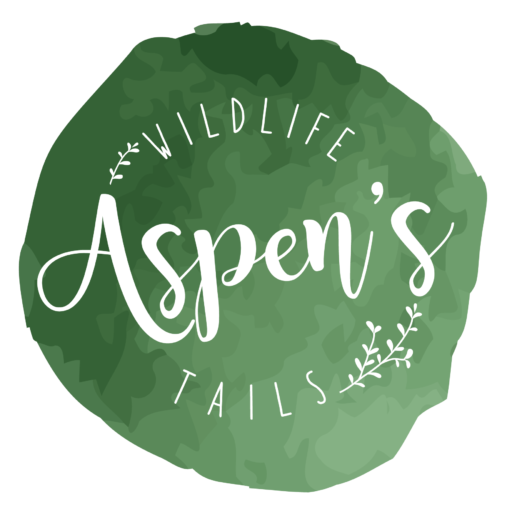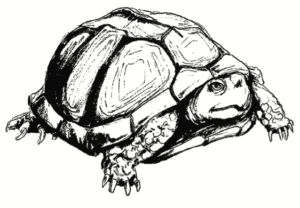The phone at the center rang, and rang, call after call. Thunderstorms rolled through the area the night before making it a very busy Saturday. Most of the calls were minor; many about birds that could either be placed back in their nests or in a new makeshift nest hung in the tree. However, there was one call that had Kim packing up her truck. In a nearby parking lot, there was a Canada goose with an injured wing that could not fly. The next thing Aspen knew she and Kim were approaching the goose. It could not fly, but it could still run! Aspen and Kim tried several times to approach the bird to capture it, only to be outrun. As they trailed the bird, they found themselves on the course of a color run through a nearby neighborhood. Runners, splashed with brightly colored powder, rushed past them, frightening the goose, causing it to run even faster. Try as they might, they could not keep up with the bird. It dodged the runners, passed through the course, and disappeared down a side street. Breathing heavy, Aspen and Kim stood at a corner stop sign, when a runner approached. “Hey, do you need some help?” he said.
“We sure do. We are trying to get that goose!” Kim replied. The sweaty runner covered in splotches of blue, green, purple and yellow from the race ran off instantly without another word. He ran like a gazelle on the African plain. He had the goose in his arms before it knew what happened, and carried it back to Kim and Aspen who were dumbfounded.
“Thank you so much,” Kim said as the runner handed the goose over.
“No, problem. Have a great day!” he said, sprinting back to the course to be showered in orange at the next color station. As they walked back to the truck laughing, the goose nipped at Kim’s shirt and neck hoping to get free. They gently placed it in the crate and returned to the center in no time.
Once there, Kim realized the goose and her shirt were both covered with colored chalk. “From the runner’s shirt,” Aspen laughed. TAP, TAP, TAP! The goose was placed in ISO, which stood for isolation, a small room off the main hospital where animals could rest and recuperate. A metal examine table stood in the center of the room, surrounded by three walls of various sized metal kennels from ground to ceiling stacked atop each other. The other wall housed two large laundry sinks, where waterfowl could swim, or various items could be disinfected and washed. The goose waited here until it was calm and could benexamined. Other ISO patients chirped and tweeted as Kim and Aspen left the room, shutting the door behind them.
TAP, TAP, TAP, “Hey Aspen,” Kim called. “You want to release that woodpecker?” TAP, TAP, TAP… “I think he is telling us he is ready to go!” TAP, TAP, TAP! The pileated woodpecker tapped on the metal bars of its cage. The young woodpecker was brought in a few weeks earlier and recovered quickly. For the last few days, it had been tapping out what sounded like Morse code on the bars. Kim gently placed the bird in Aspen’s outstretched hands and led her out the door, followed by several summer interns. They walked to the back of the property, which was surrounded by heavy woods. Aspen simply loosened her grip on the bird, expecting it to fly off ; only it did not! It just sat there, looking around as if it was not sure what was happening. Finally, it stretched its wings and took off , landing on the trunk of a pine tree just a few feet away. Gripping the bark with its zygodactyl feet, it hopped up the tree peering around at the humans on the ground. Aspen stood watching the bird for a few minutes; it fluttered to another nearby rotting tree. A few moments later the summer camp children returned from their morning nature walk. They spotted the woodpecker right away. It was, after all, a very large bird, almost eighteen inches tall, with a bright red crest atop its head. While walking back to the building, Aspen heard Morgan, the wildlife educator, telling the children all about the woodpecker and its natural history.
Once inside, Aspen was immediately summoned by Dusty, the animal care supervisor. He had wavy shoulder length, dirty blonde beach hair, always wore classic rock tees, board shorts, and black Converse. He was a walking contradiction. A laidback surfer that loved the outdoors, hiking, surfing, paddle boarding, Dusty did it all. He knew his stuff and was extremely effcient. He casually sped from one task to the next, examining, feeding, cleaning and delegating tasks to the rest of the staff. Aspen was in awe of him, as he did not take shortcuts. He was fast, knew so much and was always eager to share his knowledge with others. “Hey, let’s go examine that goose,” he said as he led her to ISO.
Aspen opened the kennel door, wrapped her arms around the goose, carefully keeping its wings folded back, and placed it on the exam table in the center of the room, where Dusty stood ready. The goose stretched its wings out with a little utter then folded them back, all the while looking back and forth between the humans. It was a very friendly goose, almost too friendly. It was evident to Dusty at once what was wrong. The wing feathers on the right side stuck out at a ninety-degree angle, rather than laying back how they should. “This is angel wing, Aspen,” Dusty said, as he continued to check the bird for other issues. “See how these feathers are sticking out like that? It’s caused by poor nutrition. People think they are nice by feeding them bread, crackers, and junk but they are in fact hurting them. Imagine if all you ever ate was fast food. You wouldn’t get the nutrients you need. Since it is an adult, its bones have already healed this way, and he will never fly again.” Dusty was running his hands over the bird, checking its eyes, mouth, wings, legs, and feet for more injuries.
“Anything else wrong?” Aspen asked.
“Nope,” Dusty replied, “I’ll let Kim know, she can have it transported to the waterfowl center,” the rehabilitation center that specialized in waterfowl. It was an amazing place. An older brick home on acres of land completely fenced in by a tall wooden privacy fence. Behind the fence lived all kinds of injured birds, socializing amongst ponds on the grassy lawn. Canadian geese, mallard ducks, roosters, and more, they were all welcomed and loved. In the meantime, since the goose was so friendly, Dusty decided to let it walk around to stretch its legs. He gently placed it on the floor. As soon as its feet hit the ground, it was off exploring the center. It quickly assessed that ISO had nothing of interest and was out the door into the main hospital.
The main room was surrounded on all four walls with counter tops and lower cabinets; the center was full, with tables that snaked around in an S pattern. Every surface was covered by plastic intake boxes containing some critter. Ten baby opossums that survived mom being killed by a car, a turtle hurt in the road, orphaned baby birds, and much more all getting the help they needed. The goose explored here and there, assessing each staff member, and intern for food. Someone was bound to have some bread the goose thought. Aspen placed a bowl of water with chopped lettuce and a few mealworms on the floor, along with another bowl of waterfowl food sprinkled with cracked corn. The goose looked up at her in confusion. It reminded her of Jack when their mom started eating healthier and made grilled chicken and asparagus rather than mac and cheese and chicken nuggets. “Don’t worry buddy; you’ll get used to it,” Aspen told the goose as it nibbled at the leg of her pants. Aspen jumped right into feeding birds and finished her shift with the goose in tow.


